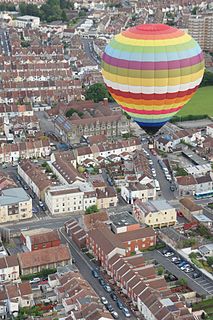 W
WIn aeronautics, a balloon is an unpowered aerostat, which remains aloft or floats due to its buoyancy. A balloon may be free, moving with the wind, or tethered to a fixed point. It is distinct from an airship, which is a powered aerostat that can propel itself through the air in a controlled manner.
 W
WAn aerostat is a lighter than air aircraft that gains its lift through the use of a buoyant gas. Aerostats include unpowered balloons and powered airships. A balloon may be free-flying or tethered. The average density of the craft is lower than the density of atmospheric air, because its main component is one or more gasbags, a lightweight skin containing a lifting gas to provide buoyancy, to which other components such as a gondola containing equipment or people are attached. Especially with airships, the gasbags are often protected by an outer envelope.
 W
WThe Allsopp Helikite is a type of kite-balloon or kytoon designed by Sandy Allsopp in the UK in 1993. The Helikite comprises a combination of a helium balloon and a kite to form a single, aerodynamically sound tethered aircraft, that exploits both wind and helium for its lift.
 W
WThe Anderson-Abruzzo Albuquerque International Balloon Museum is a museum dedicated to the worldwide history, science, and art of all types of ballooning and lighter-than-air flight. It is located in Albuquerque, New Mexico, USA, and is situated just outside the grounds used for the Albuquerque International Balloon Fiesta, the world's largest yearly balloon fiesta, and is named for Ben Abruzzo and Maxie Anderson, two Albuquerque natives who established several ballooning firsts, such as crossing oceans and continents.
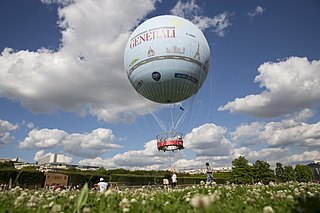 W
WThe Ballon Generali is a tethered helium balloon, used as tourist attraction and as an air quality awareness tool. Installed in Paris since 1999 in the Parc André-Citroën, it was created and developed by the French company Aerophile SAS for the celebration of the year 2000. The balloon has lofted more than 500,000 passengers into the sky since its opening.
 W
WThe "Balloon Boy" hoax occurred on October 15, 2009, when a homemade helium-filled gas balloon shaped to resemble a silver flying saucer was released into the atmosphere above Fort Collins, Colorado, by Richard and Mayumi Heene. They then claimed that their six-year-old son Falcon was trapped inside it. Authorities confirmed the balloon reached 7,000 feet (2,100 m) during its 90-minute flight. The event attracted worldwide attention, and Falcon was nicknamed "Balloon Boy" in the media.
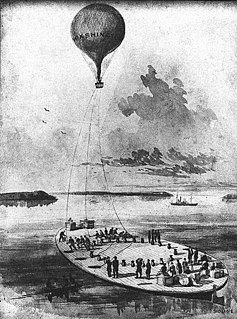 W
WA balloon carrier or balloon tender was a ship equipped with a balloon, usually tied to the ship by a rope or cable, and usually used for observation. During the second half of the 19th century and the early 20th century, these ships were built to have the furthest possible view of the surrounding waters. After several experiments, the type became formalized in the early 1900s, but was soon to be superseded by the development of seaplane carriers and regular aircraft carriers at the beginning of World War I.
 W
WBalloon propaganda campaigns in Korea include both North and South Korean propaganda leaflet campaigns through the use of balloons as a distribution method since the Korean War. A variety of other contents have also been included with the balloons. Originally, these campaigns were organized by the governments and militaries of the Korean states. Contemporarily, however, they are mainly organized by South Korean non-governmental organizations (NGOs) that regularly involve themselves in balloon release events that aim to send materials censored in North Korea, as well as various other goods, to the North Korean people.
 W
WThe Balloon Federation of America (BFA) is a 501c3 non-profit group for the advancement of lighter-than-air aviation which includes hot air and gas balloons. Founded in 1960, located in Indianola, Iowa. The BFA partners with the National Balloon Museum to induct outstanding individuals into the United States Ballooning Hall of Fame. The Federation presents multiple awards including the Ed Yost Master Pilot Award and the National Crew Person Award. The BFA facilitates balloon events by providing advice and guidance on FAA compliance.
 W
WA barrage balloon is a large uncrewed tethered kite balloon used to defend ground targets against aircraft attack, by raising aloft steel cables which pose a severe collision risk to aircraft, making the attacker's approach more difficult. The design of the kite balloon, having a shape and cable bridling which stabilise the balloon and reduce drag, meant that it could be operated with more wind than a circular balloon could. Some examples carried small explosive charges that would be pulled up against the aircraft to ensure its destruction. Barrage balloons are not practical against very high altitude flying aircraft, due to the weight of the long cable required.
 W
WThe BBC One Balloon idents were a series of idents used on BBC One from 4 October 1997 to 29 March 2002. The balloon theme replaced the computer generated spinning globe which had been used as the main ident on the channel since 1991. It launched on the same day as a BBC-wide rebrand, and thus the new idents also carried the new BBC logo. The channel's name also changed, from BBC1 to BBC One. This was the last ident set used by the channel to be used at closedown; their last closedown took place on 8 November 1997; starting the following day, BBC News 24 would broadcast on BBC One in the late night hours.
 W
WThe Bede Wing was an inflated hang glider, designed in the 1970s by aeronautical engineer Jim Bede. Intended as a safer alternative to conventional hang gliders, it resembled an early ram-air parachute, but instead was an inflatable structure, that could be filled with air for gliding, or with helium to act as a gas balloon.
 W
WA ceiling balloon also called a pilot balloon or pibal, is used by meteorologists to determine the height of the base of clouds above ground level during daylight hours. In the past, and sometimes today, a theodolite was used to track the balloon in order to determine the speed and direction of winds aloft. The principle behind the ceiling balloon is that timing of a balloon with a known ascent rate from its release until it disappears into the clouds can be used to calculate the height of the bottom of the clouds.
 W
WChalais-Meudon is an aeronautical research and development centre in Meudon, to the south-west of Paris. It was originally founded in 1793 in the nearby Château de Meudon and has played an important role in the development of French aviation.
 W
WCluster ballooning is a form of ballooning where a harness attaches a balloonist to a cluster of helium-inflated rubber balloons.
 W
WThe Columbia Scientific Balloon Facility (CSBF) is a NASA facility responsible for providing launch, tracking and control, airspace coordination, telemetry and command systems, and recovery services for unmanned high-altitude balloons. Customers of the CSBF include NASA centers, universities, and scientific groups from all over the world.
 W
WA Fu-Go , or fire balloon , was a weapon launched by Japan during World War II. A hydrogen balloon with a load varying from a 33 lb (15 kg) antipersonnel bomb to one 26-pound (12 kg) incendiary bomb and four 11 lb (5.0 kg) incendiary devices attached, it was designed as a cheap weapon intended to make use of the jet stream over the Pacific Ocean and drop bombs on American cities, forests, and farmland. Canada and Mexico reported fire balloon sightings as well.
 W
WA gas balloon is a balloon that rises and floats in the air because it is filled with a gas lighter than air. When not in flight, it is tethered to prevent it from flying away and is sealed at the bottom to prevent the escape of gas. A gas balloon may also be called a Charlière for its inventor, the Frenchman Jacques Charles. Today, familiar gas balloons include large blimps and small latex party balloons. For nearly 200 years, well into the 20th century, manned balloon flight utilized gas balloons before hot-air balloons became dominant. Without power, heat or fuel, untethered flights of gas balloons depended on the skill of the pilot. Gas balloons have greater lift for a given volume, so they do not need to be so large, and they can stay up for much longer than hot air balloons.
 W
WUSS George Washington Parke Custis was a barge acquired by the Union Navy during the American Civil War for use as a balloon-launching platform to spy on Confederate defenses from afar.
 W
WLoon LLC is an Alphabet Inc. subsidiary working on providing Internet access to rural and remote areas. The company uses high-altitude balloons in the stratosphere at an altitude of 18 km (11 mi) to 25 km (16 mi) to create an aerial wireless network with up to 1 Mbit/s speeds. A reference to the balloons used, Project Loon began as a research and development project by X in 2011, but later spun out into a separate company in July 2018.
 W
WHigh-altitude balloons are crewed or uncrewed balloons, usually filled with helium or hydrogen, that are released into the stratosphere, generally attaining between 18 and 37 km above sea level. In 2002, a balloon named BU60-1 reached a record altitude of 53.0 km.
 W
WThe history of ballooning, both with hot air and gas, spans many centuries. It includes many firsts, including the first human flight, first flight across the English Channel, first flight in North America, and first aircraft related disaster.
 W
WBalloons were one of the first mechanisms used in air warfare. Their role was originally mainly for reconnaissance purposes. They provided humans with the first available method of elevating themselves well over the battlefield to obtain the proverbial "birds-eye view." They were an early instrument of definitive intelligence collection, and were also particularly useful in the preparation of accurate battlefield maps, before which time this rudimentary craft had led to many a battlefield failure. Incendiary balloons also have a long history.
 W
WA hopper balloon is a small, one-person hot air balloon. Unlike a conventional hot air balloon where people ride inside a basket, there is no basket on a hopper balloon. Instead, the hopper pilot usually sits on a seat or wears a harness similar to a parachute harness. Hoppers are typically flown for recreation. These aircraft are sometimes called "Cloud Hoppers" or "Cloudhoppers." However, these terms formally refer to the products of a particular manufacturer, specifically Lindstrand Balloons. Nonetheless, "Cloudhopper" is used by many people as a genericized trademark, which refers to all craft of this general type. Most hopper balloons have envelopes that range in volume from 14,000 to 35,000 cubic feet and have a maximum flight duration of 1 to 1.5 hours. The two principal commercial balloon manufacturers today offering hopper balloons for sale are Cameron Balloons and Lindstrand Balloons. Most other hopper balloons are experimental aircraft designed and built by amateur constructors.
 W
WA hot air balloon is a lighter-than-air aircraft consisting of a bag, called an envelope, which contains heated air. Suspended beneath is a gondola or wicker basket, which carries passengers and a source of heat, in most cases an open flame caused by burning liquid propane. The heated air inside the envelope makes it buoyant since it has a lower density than the colder air outside the envelope. As with all aircraft, hot air balloons cannot fly beyond the atmosphere. The envelope does not have to be sealed at the bottom, since the air inside the envelope there is at about the same pressure as the surrounding air. In modern sport balloons the envelope is generally made from nylon fabric and the inlet of the balloon is made from a fire resistant material such as Nomex. Modern balloons have been made in many shapes, such as rocket ships and the shapes of various commercial products, though the traditional shape is used for most non-commercial, and many commercial, applications.
 W
WA kite balloon is a tethered balloon which is aerodynamically optimised for windy conditions by making it directionally stable and by minimising aerodynamic resistance to the wind, or drag. It typically comprises a streamlined envelope with stabilising features and a harness or yoke connecting it to the main tether.
 W
WA kytoon or kite balloon is a tethered aircraft which obtains some of its lift dynamically as a heavier-than-air kite and the rest aerostatically as a lighter-than-air balloon. The word is a portmanteau of kite and balloon.
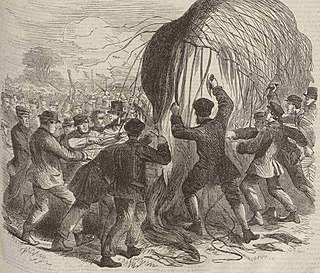 W
WThe Leicester balloon riot took place at Leicester's Victoria Park on 11 July 1864. It occurred at a test flight of a new hydrogen balloon by aeronaut Henry Tracey Coxwell, for which 50,000 spectators attended. The crowd were enraged by rumours that the balloon was not the largest and newest of Coxwell's balloons and because a woman was allegedly struck by a police officer. Coxwell's balloon was damaged, upon which he caused the gas envelope to collapse and fled, under attack from the crowd. The balloon was subsequently torn to pieces and its basket burnt. The event caused considerable expense to Coxwell who had to build a replacement balloon and set back progress in scientific high-level flights.
 W
WThe Mobile Rocket Base, abbreviated MORABA, is a department of the DLR Space Operations and Astronaut Training in Oberpfaffenhofen near Munich. Since the 1960s, the MORABA has performed scientific high altitude research missions with unmanned rockets and balloons, and has developed the required mechanical and electrical systems. Their operational areas include upper atmosphere research, microgravity research, astronomy, geophysics, materials science, as well as hypersonic research.
 W
WNight Crossing is a 1982 British-American drama film starring John Hurt, Jane Alexander and Beau Bridges. The film is based on the true story of the Strelzyk and Wetzel families, who on September 16, 1979, attempted to escape from East Germany to West Germany in a homemade hot air balloon, during the days of the Inner German border-era, when emigration to West Germany was strictly prohibited by the East German government. It was the final theatrical film directed by Delbert Mann, and the last film, too, in which Kay Walsh appeared, before retiring.
 W
WA balloon glow or night glow is an event that is often held as a climax to a hot air balloon festival. The balloons are set up at sunset in the launch area, an open field, or a football stadium and are inflated as if they are going to take off, but instead of being allowed to ascend, they are held down by the ground crew. The propane burners are ignited periodically to keep the balloons inflated with hot air.
 W
WAn observation balloon is a type of balloon that is employed as an aerial platform for intelligence gathering and artillery spotting. Use of observation balloons began during the French Revolutionary Wars, reaching their zenith during World War I, and they continue in limited use today.
 W
WOn the Threshold of Space is a 1956 drama directed by Robert D. Webb, starring Guy Madison, Virginia Leith and John Hodiak. It was Hodiak's final film; he died six months before it was released. On the Threshold of Space provides a historical depiction of air force tests made in the United States for the imminent space race.
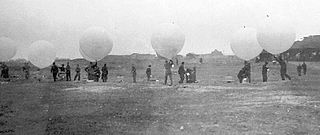 W
WOperation Outward was a British World War II program to attack Germany by means of free-flying balloons. It made use of cheap, simple balloons filled with hydrogen. They carried either a trailing steel wire intended to damage high voltage power lines by producing a short circuit, or incendiary devices that were intended to start fires in fields, forests and heathland.
 W
WProject Genetrix, also known as WS-119L, was a United States Air Force program designed to launch General Mills manufactured surveillance balloons over Communist China, Eastern Europe and the Soviet Union to take aerial photographs and collect intelligence. The Genetrix balloons reached altitudes of 50,000–100,000 feet (15–30 km), well above that flown by contemporary fighter planes.
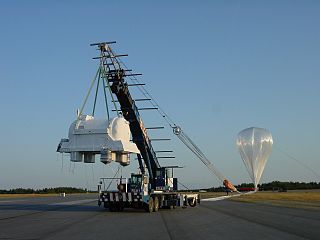 W
WResearch balloons are balloons that are used for scientific research. They are usually unmanned, filled with a lighter-than-air gas like helium, and fly at high altitudes.
 W
WA Rozière balloon is a type of hybrid balloon that has separate chambers for a non-heated lifting gas as well as for a heated lifting gas. The design was created by Jean-François Pilâtre de Rozier (1754–1785).
 W
WSpirit of Freedom balloon was a Rozière balloon designed and built by Donald Cameron and Tim Cole. In 2002 solo pilot Steve Fossett flew the Spirit of Freedom to become the first successful around-the-world nonstop solo flight in any kind of aircraft. On June 19, 2002, the 10-story-high balloon Spirit of Freedom lifted off from Northam, Western Australia, and landed in Queensland, Australia, on July 3, 2002. The solo flight circumnavigation lasted 13 days, 8 hours, 33 minutes and covered 20,626.48 statute miles (33,195.10 km). They reached speeds of up to 322 kilometers per hour, and flew as high as 10,580 meters.
 W
WA sky lantern, also known as Kǒngmíng lantern, or Chinese lantern, is a small hot air balloon made of paper, with an opening at the bottom where a small fire is suspended.
 W
WSkyhook balloons were high-altitude balloons developed by Otto C. Winzen and General Mills, Inc. They were used by the United States Navy Office of Naval Research (ONR) in the late 1940s and 1950s for atmospheric research, especially for constant-level meteorological observations at very high altitudes. Instruments like the Cherenkov detector were first used on Skyhook balloons.
 W
WA solar balloon is a balloon that gains buoyancy when the air inside is heated by solar radiation, usually with the help of black or dark balloon material. The heated air inside the solar balloon expands and has lower density than the surrounding air. As such, a solar balloon is similar to a hot air balloon. Usage of solar balloons is predominantly in the toy market, although it has been proposed that they be used in the investigation of planet Mars, and some solar balloons are large enough for human flight. A vent at the top can be opened to release hot air for descent and deflation.
 W
WStowaway in the Sky is a 1960 French family adventure film, in Dyaliscope and Eastman Color, directed by Albert Lamorisse.
 W
WA superpressure balloon (SPB) is a style of aerostatic balloon where the volume of the balloon is kept relatively constant in the face of changes in ambient pressure outside the balloon, and the temperature of the contained lifting gas. This allows the balloon to keep a stable altitude for long periods. This is in contrast with much more common variable-volume balloons, which are either only partially filled with lifting gas, or made with more elastic materials. Also referred to as pumpkin or Ultra Long Distance Balloons (ULDB) balloons, the sealed balloon envelopes have a pumpkin shape at flight altitude. In a variable-volume balloon, the volume of the lifting gas changes due to heating and cooling in the diurnal cycle. The cycle is magnified by a greenhouse effect inside the balloon, while the surrounding atmospheric gas is subject to a much more limited cyclical temperature change. As the lift gas heats and expands, the displacement of atmospheric gas increases, while the balloon weight remains constant. Its buoyancy increases, and this leads to a rise in altitude unless it is compensated by venting gas. Conversely, if the balloon cools and drops, it becomes necessary to release ballast. Since both ballast and gas are finite, there is a limit to how long a variable-volume balloon can compensate in order to stabilize its altitude. In contrast, a superpressure balloon will change altitude much less without compensation maneuvers.
 W
WA tethered, moored or captive balloon is a balloon that is restrained by one or more tethers attached to the ground and so it cannot float freely. The base of the tether is wound around the drum of a winch, which may be fixed or mounted on a vehicle, and is used to raise and lower the balloon.
 W
WThe Twenty-One Balloons is a novel by William Pène du Bois, published in 1947 by the Viking Press and awarded the Newbery Medal for excellence in American children's literature in 1948. The story is about a retired schoolteacher whose ill-fated balloon trip leads him to discover an island full of great wealth and fantastic inventions. The events and ideas are based both on scientific fact and imagination, and the descriptions are accompanied by illustrations by du Bois.
 W
WThe Union Army Balloon Corps was a branch of the Union Army during the American Civil War, established by presidential appointee Thaddeus S. C. Lowe. It was organized as a civilian operation, which employed a group of prominent American aeronauts and seven specially built, gas-filled balloons to perform aerial reconnaissance on the Confederate States Army.
 W
WVirgin Balloon Flights, with headquarters in Telford, Shropshire, began flying hot air balloons in 1994 and its passengers are still flown in red and white balloons with the Virgin Group logo on the side of the balloon.
 W
WA weather balloon also known as sounding balloon is a balloon that carries instruments aloft to send back information on atmospheric pressure, temperature, humidity and wind speed by means of a small, expendable measuring device called a radiosonde. To obtain wind data, they can be tracked by radar, radio direction finding, or navigation systems. Balloons meant to stay at a constant altitude for long periods of time are known as transosondes. Weather balloons that do not carry an instrument pack are used to determine upper-level winds and the height of cloud layers. For such balloons, a theodolite or total station is used to track the balloon's azimuth and elevation, which are then converted to estimated wind speed and direction and/or cloud height, as applicable.
 W
WWorld View Enterprises, Inc., doing business as World View, is a private American near-space exploration and technology company headquartered in Tucson, Arizona, founded with the goal of increasing access to and the utilization of the stratosphere for scientific, commercial, and economic purposes.
 W
WZero 2 Infinity is a private Spanish company developing high-altitude balloons to provide access to near space and low Earth orbit using a balloon-borne pod and a balloon-borne launcher.